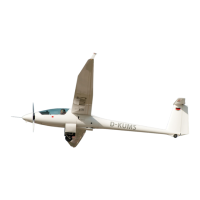Maintenance Manual STEMME S10
Date of Issue Oct. 01, 1990 page: 15
Amendment No.: 4 Date: May 26, 1993
A4010021_B19.doc
Doc.No.: A40-10-021
One fuel tank is installed in each outboard area of the central wing between spar and leading edge. The fuel
tanks are made of a hybrid laminate. To ensure long-time resistance, the internal surfaces of the tanks are
coated with a fuel-resistant protection film "Scotch Clad 776" (3M Company; MIL-D-1795-B).
The fuel is supplied from the tank through a pipe of relatively large cross section to the central wing root. At
this point, a finger strainer combined with a flexible hose fitting is installed. From this flexible hose fitting, the
fuel line - equipped with a fine filter - is conducted to the water separator. A flexible hose of 0.4 in. (10 mm)
internal diameter leading to the drainer in the wheel well serves as a water trap. The fuel line is directed from
the water separator via the associated shut-off valve to the fuel pumps. Beyond those, both systems are
cross-connected and then piped on to the distribution line of the carburettors. The main pump of the left hand
fuel system is mechanically driven from the engine (and located on it), the right hand system is provided with
an electrically driven main pump.
The fuel tank vent is located close to the filler cap. From this point, an aluminium tube Ø 8 x 1 mm is installed
over a length of 5.25 ft. (1.60 m) towards the fuselage and then back to the wing attachment point. The fuel
tank vent discharges on the wing lower side at the attachment. The discharge opening is tapered by 45°
towards flight direction (thus ramming intake).
3.3.3 Oil System
A thermostat-controlled oil cooler (switching point 176°F / 80°C) is installed in the main oil flow of the engine.
The oil cooler is located on the left side of the central fuselage framework. The connection to the fittings on
the engine is realised by means of flexible hoses with metal reinforcement and a fire-resistant sheathing.
3.3.4 Cooling System
The engine is cooled by ram air. The air inlets are to the left and to the right side of the central fuselage
cowlings. From these inlets, the cooling air flows directly to the cylinder heads. A minor portion of the cooling
air is blown into the engine compartment through several openings. On the left side of the central fuselage
cowling, the cooling air duct is continued to the oil cooler. The cooling air outlet is located in the lower cowling
of the central fuselage. Both inlet flaps and the waste air flap are synchronously operated by means of
bowden cables, which are directed into the cockpit and attached to a bell-crank lever in the left leg room
(behind the cover). This bell-crank lever to close the flaps is actuated together with the propeller dome
control. All three flaps are opened by means of springs attached to the flaps, when the propeller dome is
opened and the bell-crank lever released.
3.3.5 Induction System
The screens of the engine induction system are mounted on the firewall. The air is supplied through air inlets
at the upper end of the vertical stabiliser, through the tail boom and air inlets in the front and central areas of
the fuselage. From the induction system screens, the air is supplied through a spiral hose duct to the
carburettors.
3.3.6 Exhaust System
The arrangement of the exhaust system can be seen from the general view figure 3.3.a:
The exhaust manifolds are directed beneath the engine with slight lateral displacement rearwards to a
muffler. Drip pans are installed beneath the carburettors in order to collect possible fuel leakage and to divert
leaking fuel around the exhaust manifold. The exhaust gases discharge from the muffler directly down
through the lower engine cowling.
The whole exhaust system is made of corrosion resistant steel. It is attached exclusively to the engine.

